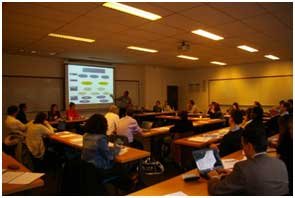IRT Nanoelec has initiated a project to assess the socioeconomic impact of its activities. The assessments, planned for 2017 and 2020, will factor in the contributions of several experts using different but complementary methods. To ensure that the assessment is both collaborative and participatory, IRT Nanoelec held an initial meeting on February 2 at Grenoble Ecole de Management on “Assessing Impact and Performance. The Case of IRT Nanoelec.”

The IRT Nanoelec socioeconomic impact assessment will respond to the broader requirements of France’s Commissioner-General for Investment to measure the impact of France’s economic stimulus package and the package’s various instruments in an approach that goes beyond measuring investments and results.
What makes IRT Nanoelec different from existing tech transfer instruments in the field of nanoelectronics is the joint creation and transfer of new knowledge and technologies across an expanded consortium of partners from the public and private sectors. IRT Nanoelec partners interact in a semi-open innovation framework governed by a consortium agreement.
The assessment will look at:
- How to measure the intensity of joint production, knowledge creation, and value sharing for IRT Nanoelec industrial partners
- How to measure performance using a results-oriented approach that goes beyond investment/resources allocated
- How to apply methods and indicators used by other innovation stakeholders in France and, more broadly, Europe
- What relevant, reproducible frameworks could be used by IRT Nanoelec and, potentially, other IRTs or other instruments of France’s economic stimulus package
A multidisciplinary team has been formed to conduct the assessment and includes academic researchers in the fields of assessment, collaboration, and human resources. They have already determined the foundations for the upcoming assessment, selected the methods and tools that will be used, and validated sources of data. The meeting held on February 2, 2016 provided an opportunity to confirm the benefits of the assessment and discuss extending it with the concerned stakeholders.
In addition to the experts contributing to the assessment, the meeting was attended by a variety of stakeholders representing the CEA, Mentor Graphics, Schneider Electric, ERSF, the Greater Grenoble Intermunicipal Authority, IRT Bioaster, Tennerdis, Minalogic, the Grenoble Chamber of Commerce, Grenoble Institute of Technology, and Grenoble-Alpes University. Other interested stakeholders were unable to send representatives to the meeting (France’s Commissioner-General for Investment, the French National Research Agency, other IRTs, and the Auvergne Rhône-Alpes regional government) but are following the developments closely. The meeting provided an opportunity for active, constructive discussion among stakeholders from all horizons: IRT Nanoelec member companies, academic institutions, and government. Comparing and contrasting a variety of perspectives—a VP for industrial innovation at an IRT Nanoelec member company, a local government administrator, a director of a research organization—will help push the assessment in the right direction. And factoring in the needs and expectations of all stakeholders is essential to this kind of collaborative, participatory assessment. And, because you can’t improve what you can’t measure, the assessment will drive performance, beyond what is legally required under the French government’s economic stimulus package. This long-term initiative will result in a first report in mid-2017 and will continue throughout IRT Nanoelec’s lifetime.




